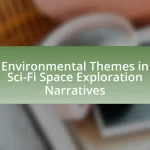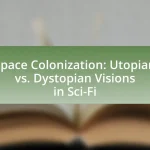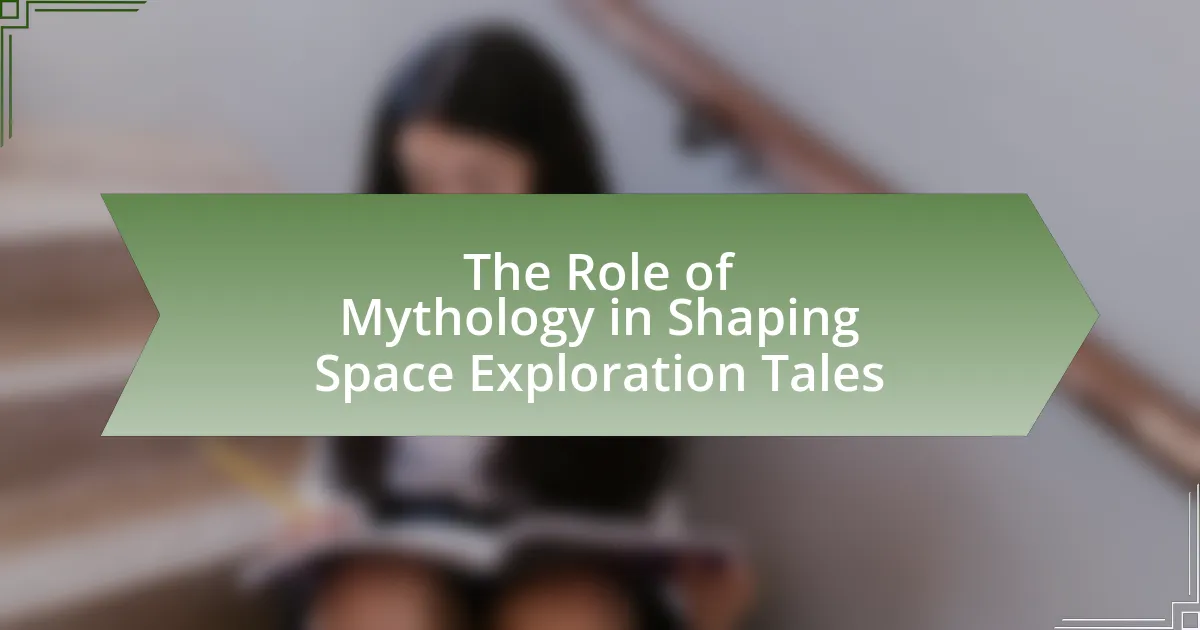The article examines the evolution of space travel technology as depicted in science fiction novels, tracing its development from early works like Jules Verne’s “From the Earth to the Moon” to contemporary narratives such as “The Expanse.” It highlights key technological concepts introduced in early literature, the influence of societal views on these portrayals, and significant advancements in mid-20th century sci-fi. The discussion includes the impact of the space race on narrative realism, the ethical implications of space colonization, and how modern authors address emerging technologies and their societal effects. Overall, the article provides a comprehensive overview of how sci-fi literature reflects and shapes our understanding of space exploration and its future possibilities.
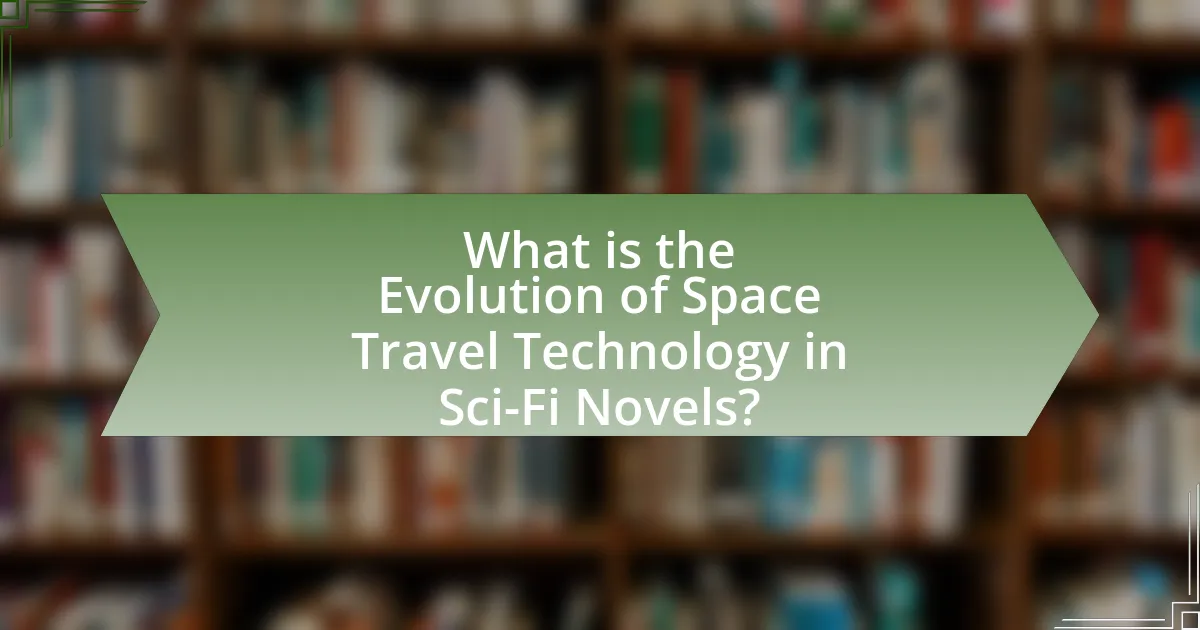
What is the Evolution of Space Travel Technology in Sci-Fi Novels?
The evolution of space travel technology in sci-fi novels has progressed from rudimentary concepts to complex, scientifically grounded theories. Early works, such as Jules Verne’s “From the Earth to the Moon” (1865), introduced basic rocket concepts, while later novels like Arthur C. Clarke’s “2001: A Space Odyssey” (1968) depicted advanced technologies like space stations and artificial intelligence. The introduction of concepts such as faster-than-light travel in works like Frank Herbert’s “Dune” (1965) and the exploration of wormholes in novels like “The Forever War” by Joe Haldeman (1974) further expanded the narrative possibilities. This trajectory reflects not only technological advancements in real-world space exploration but also the influence of scientific theories, such as relativity and quantum mechanics, on the genre.
How has space travel technology been portrayed in early sci-fi literature?
Space travel technology in early sci-fi literature has often been depicted as a blend of imaginative speculation and rudimentary scientific principles. Works such as Jules Verne’s “From the Earth to the Moon” (1865) illustrate the concept of launching a projectile into space using a giant cannon, reflecting the era’s fascination with engineering and exploration. Similarly, H.G. Wells’ “The First Men in the Moon” (1901) introduces the idea of a spacecraft powered by a fictional anti-gravity substance, showcasing early attempts to conceptualize propulsion methods beyond contemporary technology. These portrayals highlight the optimism and curiosity of the time, as authors sought to explore the possibilities of human expansion into the cosmos, often grounded in the scientific understanding of their day.
What were the key technological concepts introduced in early works?
The key technological concepts introduced in early works of science fiction include space travel, faster-than-light (FTL) propulsion, and advanced robotics. Early novels like Jules Verne’s “From the Earth to the Moon” (1865) presented the idea of launching spacecraft, while H.G. Wells’ “The War of the Worlds” (1898) introduced extraterrestrial technology and interplanetary travel. Concepts such as FTL propulsion were further explored in works like E.E. “Doc” Smith’s “Lensman” series, which proposed the idea of warp drives. Additionally, early depictions of robots, as seen in Karel Čapek’s play “R.U.R.” (1920), laid the groundwork for future explorations of artificial intelligence in space exploration narratives. These foundational ideas have significantly influenced the trajectory of space travel technology in both literature and real-world advancements.
How did societal views influence these early portrayals?
Societal views significantly influenced early portrayals of space travel technology in sci-fi novels by reflecting contemporary beliefs, fears, and aspirations. For instance, during the early 20th century, the rise of industrialization and technological optimism led authors like H.G. Wells to envision advanced space travel as a symbol of human progress and exploration. Conversely, societal anxieties about war and the unknown, particularly during the Cold War era, shaped narratives that depicted space travel as a potential threat or a race for supremacy, as seen in works like Arthur C. Clarke’s “2001: A Space Odyssey.” These portrayals were not merely imaginative; they mirrored the prevailing cultural context, illustrating how societal attitudes directly impacted the themes and technologies represented in early sci-fi literature.
What major advancements in space travel technology are depicted in mid-20th century sci-fi?
Major advancements in space travel technology depicted in mid-20th century sci-fi include the development of faster-than-light travel, advanced spacecraft designs, and the concept of space colonies. Notable examples include the use of warp drives in works like “Star Trek,” which introduced the idea of traveling at speeds exceeding that of light, fundamentally altering perceptions of interstellar travel. Additionally, Arthur C. Clarke’s “2001: A Space Odyssey” showcased sophisticated spacecraft capable of artificial intelligence and automated navigation, reflecting contemporary technological aspirations. The portrayal of space colonies in works such as “The Dispossessed” by Ursula K. Le Guin illustrated the potential for human habitation beyond Earth, emphasizing the social and political implications of space exploration. These advancements not only inspired real-world scientific endeavors but also shaped public imagination regarding the future of space travel.
Which novels marked significant technological breakthroughs in their narratives?
“Neuromancer” by William Gibson marked a significant technological breakthrough in its narrative by introducing the concept of cyberspace and virtual reality, which influenced the development of the internet and digital culture. Additionally, “The Martian” by Andy Weir showcased realistic space travel technology and survival techniques on Mars, emphasizing the use of contemporary scientific principles. Both novels have had a lasting impact on the portrayal of technology in literature and have inspired advancements in real-world technology.
How did the space race impact sci-fi representations of space travel?
The space race significantly influenced sci-fi representations of space travel by introducing realistic technological advancements and a sense of urgency in exploration narratives. During the 1950s and 1960s, as the United States and the Soviet Union competed to achieve milestones in space exploration, sci-fi literature began to reflect these developments, showcasing more scientifically plausible spacecraft and missions. For instance, works like Arthur C. Clarke’s “2001: A Space Odyssey” incorporated contemporary scientific understanding and speculative technology, such as space stations and artificial intelligence, which were inspired by the actual advancements made during the space race, including the launch of Sputnik in 1957 and the Apollo moon landing in 1969. This alignment between real-world events and fictional portrayals helped to shape public perception of space travel as both achievable and imminent, thereby enhancing the genre’s popularity and credibility.
How has contemporary sci-fi redefined space travel technology?
Contemporary sci-fi has redefined space travel technology by introducing advanced concepts such as faster-than-light travel, artificial intelligence navigation, and sustainable life support systems. These innovations, often depicted in works like “The Expanse” series and “Interstellar,” challenge traditional notions of physics and engineering, inspiring real-world research and development. For instance, the concept of the Alcubierre warp drive, popularized by sci-fi, has prompted theoretical discussions among physicists about the feasibility of bending space-time for faster travel. Additionally, the portrayal of autonomous spacecraft in contemporary narratives has influenced the design of robotic missions, such as NASA’s Perseverance rover, which utilizes AI for navigation and decision-making.
What new technologies are commonly featured in modern sci-fi novels?
Modern sci-fi novels commonly feature advanced technologies such as artificial intelligence, virtual reality, biotechnology, and space travel innovations like faster-than-light propulsion systems. These technologies reflect contemporary scientific advancements and speculative future developments. For instance, artificial intelligence is often depicted as sentient beings or advanced systems that interact with humans, showcasing the potential of machine learning and neural networks. Virtual reality is frequently used to explore immersive worlds, paralleling advancements in gaming and simulation technologies. Biotechnology, including genetic engineering and synthetic biology, is portrayed in narratives that examine ethical implications and human enhancement. Space travel technologies, particularly concepts like warp drives or wormholes, are inspired by theoretical physics, illustrating humanity’s quest for interstellar exploration.
How do contemporary authors address the ethical implications of space travel?
Contemporary authors address the ethical implications of space travel by exploring themes such as colonialism, environmental responsibility, and the consequences of technological advancement. For instance, in Kim Stanley Robinson’s “Mars Trilogy,” the narrative delves into the moral dilemmas of terraforming Mars, highlighting the potential ecological impacts and the ethical considerations of altering another planet’s environment. Additionally, in “The Expanse” series by James S.A. Corey, the authors examine the socio-political ramifications of space colonization, reflecting on issues of power dynamics and resource exploitation. These narratives serve to provoke critical thought about humanity’s responsibilities in the cosmos, emphasizing the need for ethical frameworks as space exploration progresses.
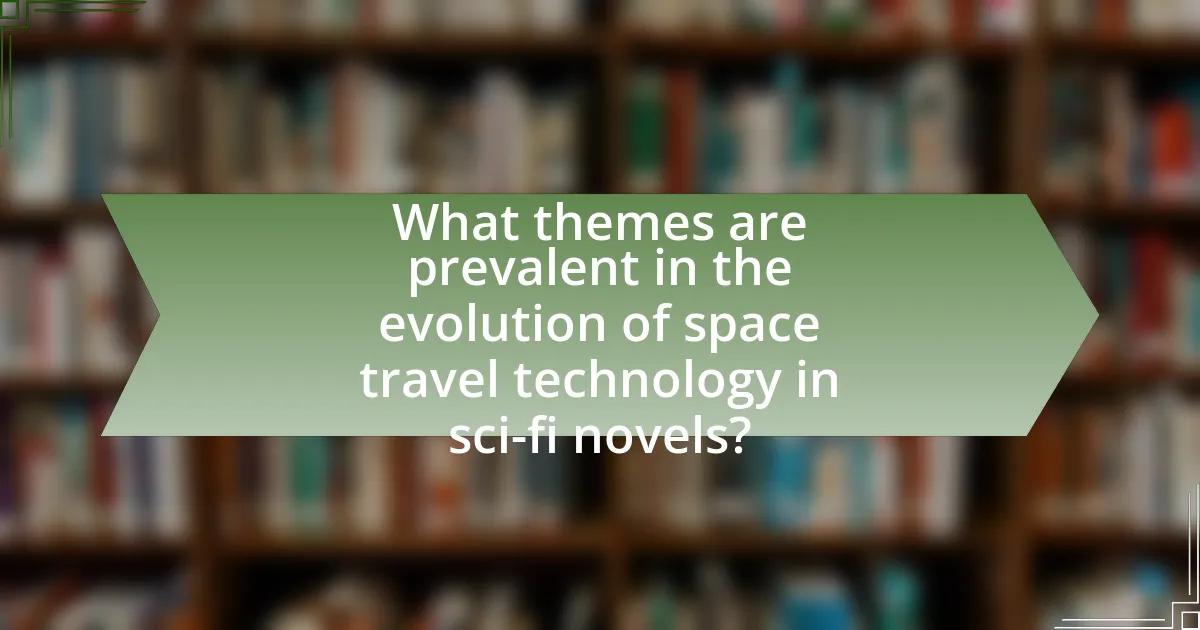
What themes are prevalent in the evolution of space travel technology in sci-fi novels?
Prevalent themes in the evolution of space travel technology in sci-fi novels include the quest for exploration, the impact of technology on society, and the ethical implications of space colonization. The quest for exploration reflects humanity’s innate desire to discover new worlds, often depicted through advanced spacecraft and propulsion systems, as seen in works like Arthur C. Clarke’s “Rendezvous with Rama.” The impact of technology on society is illustrated by how advancements in space travel alter human relationships and societal structures, a theme explored in Isaac Asimov’s “Foundation” series. Ethical implications arise in narratives that question the morality of colonizing other planets, as highlighted in Kim Stanley Robinson’s “Mars Trilogy,” where the consequences of terraforming and resource exploitation are critically examined. These themes collectively illustrate the complex interplay between human ambition, technological progress, and moral responsibility in the context of space travel.
How do themes of exploration and adventure manifest in space travel narratives?
Themes of exploration and adventure in space travel narratives manifest through the depiction of uncharted territories, the quest for knowledge, and the human spirit’s resilience in the face of the unknown. These narratives often illustrate characters embarking on journeys to distant planets or galaxies, driven by curiosity and the desire to discover new worlds, as seen in works like Arthur C. Clarke’s “2001: A Space Odyssey,” where the exploration of space leads to profound existential questions. Additionally, the challenges faced during these journeys, such as encounters with alien species or navigating treacherous environments, highlight the adventurous aspect, emphasizing the unpredictability and excitement of space travel. This is supported by the historical context of space exploration, such as NASA’s Apollo missions, which inspired countless sci-fi stories that reflect humanity’s aspirations and fears regarding the cosmos.
What role does human curiosity play in these stories?
Human curiosity serves as a driving force in the narratives of sci-fi novels focused on the evolution of space travel technology. This innate desire to explore the unknown propels characters to seek out new worlds, confront challenges, and innovate technologies that push the boundaries of human capability. For instance, in Arthur C. Clarke’s “2001: A Space Odyssey,” the quest for knowledge leads to the development of advanced AI and space travel, illustrating how curiosity fuels technological advancement. Such stories often reflect humanity’s relentless pursuit of understanding the universe, showcasing how curiosity not only motivates exploration but also catalyzes significant technological breakthroughs.
How do authors depict the challenges of space exploration?
Authors depict the challenges of space exploration through themes of isolation, technological limitations, and the psychological effects on astronauts. For instance, in Arthur C. Clarke’s “2001: A Space Odyssey,” the isolation of the crew aboard the Discovery One spacecraft highlights the mental strain of prolonged space travel. Additionally, in Andy Weir’s “The Martian,” the protagonist faces the harsh realities of survival on Mars, showcasing the limitations of technology and human ingenuity in overcoming environmental challenges. These narratives often reflect real scientific concerns, such as the effects of microgravity on the human body and the complexities of life support systems, emphasizing the multifaceted difficulties inherent in space exploration.
What are the implications of advanced space travel technology on society in sci-fi?
Advanced space travel technology in sci-fi significantly alters societal structures, economies, and cultural perspectives. For instance, the ability to travel between planets fosters a new era of exploration and colonization, leading to the establishment of interstellar societies and economies, as depicted in works like “The Expanse” series by James S.A. Corey. This technology also raises ethical questions regarding resource exploitation and the treatment of extraterrestrial life, as seen in “Avatar” by James Cameron, where advanced technology leads to conflicts over natural resources. Furthermore, the portrayal of advanced space travel often reflects contemporary societal issues, such as inequality and environmental concerns, suggesting that these narratives serve as a mirror to current human challenges.
How do different authors envision the impact of space colonization?
Different authors envision the impact of space colonization as a transformative force for humanity, often highlighting both its potential benefits and ethical dilemmas. For instance, Arthur C. Clarke in “Rendezvous with Rama” portrays space colonization as a means to expand human knowledge and experience, suggesting that it could lead to a greater understanding of the universe. Conversely, Kim Stanley Robinson in “Red Mars” emphasizes the environmental and social challenges that colonization poses, illustrating the potential for conflict over resources and the ethical implications of terraforming. These contrasting perspectives reflect a broader discourse in science fiction, where the impact of space colonization is seen as a catalyst for both progress and peril, underscoring the complexities of human expansion into the cosmos.
What societal changes are often portrayed as a result of space travel advancements?
Societal changes often portrayed as a result of space travel advancements include increased global cooperation, technological innovation, and shifts in cultural perspectives. In many sci-fi narratives, the challenges of space exploration necessitate collaboration among nations, leading to a united global effort, as seen in works like Arthur C. Clarke’s “Rendezvous with Rama.” Additionally, advancements in space travel often drive technological progress in other fields, such as communication and materials science, exemplified by the development of satellite technology that has transformed everyday life. Cultural perspectives also shift, with humanity’s place in the universe being redefined, as illustrated in Isaac Asimov’s “Foundation” series, where the exploration of space prompts philosophical inquiries about existence and identity.
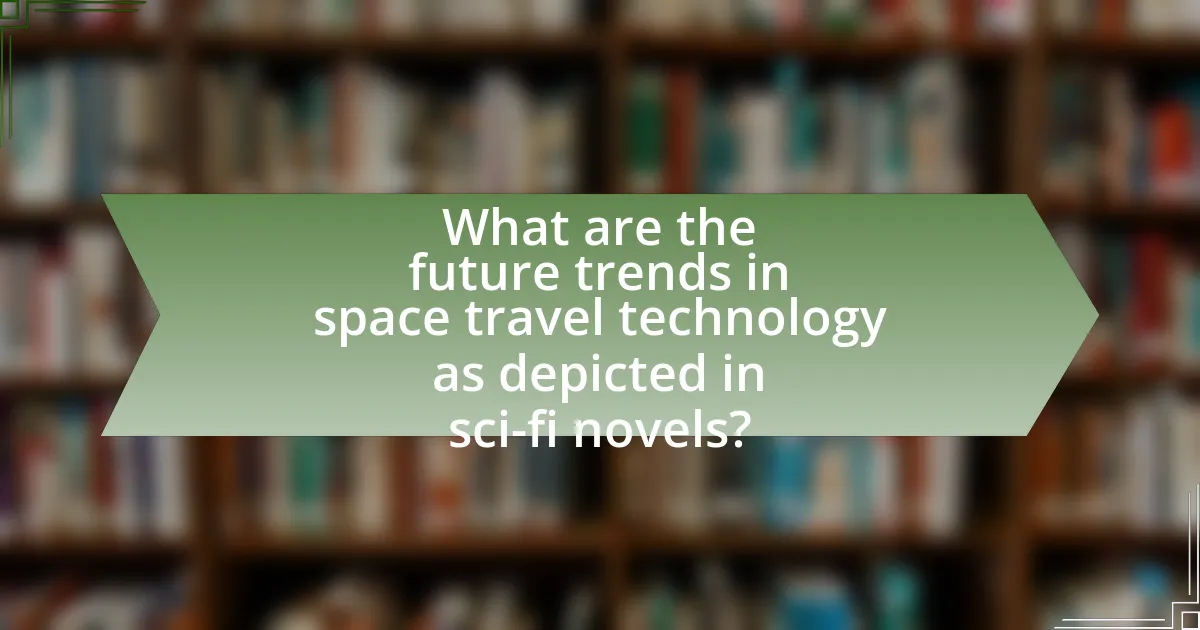
What are the future trends in space travel technology as depicted in sci-fi novels?
Future trends in space travel technology as depicted in sci-fi novels include advanced propulsion systems, colonization of other planets, and artificial intelligence integration. Novels like “The Expanse” series showcase the use of fusion drives and railguns for efficient travel and combat in space, while “Red Mars” explores the terraforming and colonization of Mars, highlighting humanity’s expansion beyond Earth. Additionally, works such as “Neuromancer” illustrate the role of AI in managing spacecraft and optimizing travel routes, reflecting current discussions in technology about autonomous systems. These trends emphasize a shift towards more sustainable and efficient methods of space exploration, mirroring ongoing advancements in real-world aerospace engineering.
How are emerging technologies influencing the narrative of space travel in recent works?
Emerging technologies are significantly influencing the narrative of space travel in recent works by introducing advanced concepts such as artificial intelligence, quantum computing, and biotechnology. These technologies enhance storytelling by providing realistic frameworks for space exploration, enabling authors to explore complex themes like human-machine interaction and the ethical implications of space colonization. For instance, novels like “The Martian” by Andy Weir utilize real scientific principles and technologies, such as the use of robotics and life support systems, to create plausible scenarios that resonate with contemporary advancements in space technology. This integration of emerging technologies not only enriches the narrative but also reflects society’s growing interest in actual space missions and the future of human life beyond Earth.
What role do artificial intelligence and robotics play in future space travel?
Artificial intelligence and robotics are crucial for enhancing the efficiency, safety, and autonomy of future space travel. AI systems can analyze vast amounts of data in real-time, enabling spacecraft to make informed decisions during missions, such as navigation and hazard avoidance. Robotics, including autonomous drones and rovers, can perform tasks on extraterrestrial surfaces, conduct repairs, and gather scientific data without direct human intervention. For instance, NASA’s Mars rovers, equipped with AI, have successfully navigated complex terrains and conducted experiments, demonstrating the potential of these technologies in space exploration.
How do authors speculate on the future of human and alien interactions in space?
Authors speculate on the future of human and alien interactions in space by envisioning scenarios that range from peaceful coexistence to conflict-driven encounters. For instance, in works like Arthur C. Clarke’s “Childhood’s End,” humanity experiences a transformative relationship with advanced alien beings, suggesting a future where collaboration leads to significant evolution in human society. Conversely, in films like “Arrival,” the narrative explores the complexities of communication and understanding between species, highlighting the potential for both cooperation and misunderstanding. These speculative narratives often reflect contemporary societal concerns, such as technological advancement and ethical dilemmas, illustrating how authors use fictional frameworks to explore the implications of interspecies interactions in a future shaped by space travel.
What lessons can be learned from the evolution of space travel technology in sci-fi novels?
The evolution of space travel technology in sci-fi novels teaches that technological advancements often reflect societal aspirations and fears. For instance, early works like Jules Verne’s “From the Earth to the Moon” (1865) showcased humanity’s desire for exploration and innovation, while later novels, such as Arthur C. Clarke’s “2001: A Space Odyssey” (1968), highlighted the complexities and ethical dilemmas of advanced technology. These narratives illustrate how speculative technology can inspire real-world scientific progress, as seen in the development of satellite technology and space exploration missions influenced by sci-fi concepts. Furthermore, the portrayal of space travel in these novels often serves as a cautionary tale about the potential consequences of unchecked technological growth, emphasizing the need for responsible innovation.
How can these narratives inform real-world space exploration efforts?
Narratives in science fiction novels can inform real-world space exploration efforts by providing imaginative frameworks that inspire technological innovation and problem-solving. For instance, concepts like faster-than-light travel and advanced life-support systems, as depicted in works such as Arthur C. Clarke’s “2001: A Space Odyssey,” have spurred real scientific inquiry and engineering projects aimed at developing similar technologies. Additionally, the ethical dilemmas and societal implications explored in these narratives encourage critical discussions among scientists and policymakers, shaping the direction of space exploration initiatives. The influence of sci-fi on actual space missions is evident in NASA’s use of speculative design to envision future habitats on Mars, demonstrating how fictional narratives can translate into practical exploration strategies.
What best practices can be derived from sci-fi portrayals of space travel technology?
Best practices derived from sci-fi portrayals of space travel technology include prioritizing sustainability, enhancing human adaptability, and fostering international collaboration. Sci-fi narratives often emphasize the importance of eco-friendly propulsion systems, as seen in works like “The Expanse,” where advanced technologies minimize environmental impact. Additionally, stories such as “Interstellar” highlight the necessity for human adaptability in extreme environments, suggesting that future technologies should incorporate life-support systems that enhance resilience. Lastly, many sci-fi scenarios, like those in “Star Trek,” advocate for global cooperation in space exploration, indicating that collaborative frameworks can lead to more effective technological advancements and shared knowledge. These portrayals provide a roadmap for real-world space travel initiatives, emphasizing the need for responsible innovation and teamwork.

